

The New Arms Race in AI. The "Father of Artificial Intelligence" Says Singularity Is 30 Years Away. You’ve probably been told that the singularity is coming.
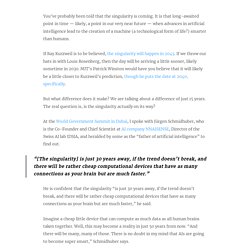
World Leaders Have Decided: The Next Step in AI is Augmenting Humans. Think that human augmentation is still decades away?
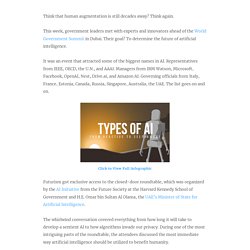
Think again. This week, government leaders met with experts and innovators ahead of the World Government Summit in Dubai. An AI-Powered Network Could Save the US Navy Billions of Dollars. In Brief The US Navy is working to improve operations by connecting their fleets and strategic locations using artificial intelligence.
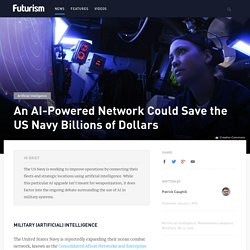
While this particular AI upgrade isn't meant for weaponization, it does factor into the ongoing debate surrounding the use of AI in military systems. Military (Artificial) Intelligence The United States Navy is reportedly expanding their ocean combat network, known as the Consolidated Afloat Networks and Enterprise Services (CANES), to seamlessly connect their ships, submarines, and on-shore locations using artificial intelligence (AI). Researchers Create Self-Repairing Electrical Circuit. In Brief Scientists have fabricated a flexible electrical circuit that, when cut into two pieces, can repair itself and fully restore its original conductivity.

The circuit is made of a new gel that possesses a combination of properties that are not typically seen together: high conductivity, flexibility, and room-temperature self-healing.The gel could potentially offer self-healing for a variety of applications, including flexible electronics, soft robotics, artificial skins, biomimetic prostheses, and energy storage devices.The researchers also hope that, by combining supramolecular chemistry and polymer nanoscience, the resulting hybrid gels may provide a useful strategy for designing new self-healing materials. The paper was published in a recent issue of Nano Letters. Sci-Fi Sunday: What Happens When Our Technology Outpaces Our Understanding? Though the sci-fi short “Burnt Grass” deals with themes related to futuristic technologies, it doesn’t bother to develop said future in detail.

It is, after all, a short film. You’ve got to pick your battles. What does the director substitute for matter transporters and clone farms? Yup. Creator of Google DeepMind: Terminator is an "extremely unrealistic" example of AI. In Brief Demis Hassabis, the leader of Google's machine learning efforts, is joining luminaries like Elon Musk in calling for a debate on the role of ethics in AI development.

What It Is “I think we have to be aware of that and I think that people developing that – us and other companies and universities – need to realize and take seriously our responsibilities and to have ethical concerns at the top of our minds,” Hassabis told the BBC, adding that Musk brought the concerns to his attention. U.S. Navy AI To Predict Pirate Attacks. The US Navy is developing a method of maping possible pirate attacks.
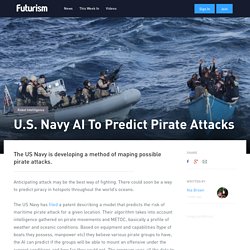
Anticipating attack may be the best way of fighting. There could soon be a way to predict piracy in hotspots throughout the world’s oceans. The US Navy has filed a patent describing a model that predicts the risk of maritime pirate attack for a given location. Their algorithm takes into account intelligence gathered on pirate movements and METOC, basically a profile of weather and oceanic conditions. Based on equipment and capabilities (type of boats they possess, manpower etc) they believe various pirate groups to have, the AI can predict if the groups will be able to mount an offensive under the current conditions and how far they could get. Wikimedia Commons Oceans Beyond Piracy’s Maritime Piracy 2014 assessment reports that a total of 5,009 seafarers were attacked by pirates that year. Source: ScienceAlert. Autonomous Reproduction: Evolving Robots Are Here.
A study by the University of Cambridge examined the "evolution" of robots, where a mother robot created increasingly successful offspring based on natural selection.
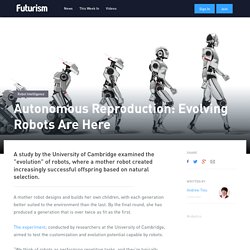
A mother robot designs and builds her own children, with each generation better suited to the environment than the last. By the final round, she has produced a generation that is over twice as fit as the first. The experiment, conducted by researchers at the University of Cambridge, aimed to test the customization and evolution potential capable by robots. “We think of robots as performing repetitive tasks, and they’re typically designed for mass production instead of mass customization,”says lead researcher Dr. What you need to know about artificial intelligence, and the imminent robot future. Do androids dream of electric sheep?
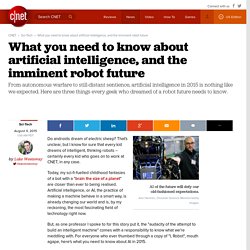
That's unclear, but I know for sure that every kid dreams of intelligent, thinking robots -- certainly every kid who goes on to work at CNET, in any case. Today, my sci-fi-fuelled childhood fantasies of a bot with a "brain the size of a planet" are closer than ever to being realised. Artificial intelligence, or AI, the practice of making a machine behave in a smart way, is already changing our world and is, by my reckoning, the most fascinating field of technology right now. But, as one professor I spoke to for this story put it, the "audacity of the attempt to build an intelligent machine" comes with a responsibility to know what we're meddling with. For everyone who ever thumbed through a copy of "I, Robot", mouth agape, here's what you need to know about AI in 2015. Robots are very close to killing us. Could Bitcoin Be The Key to Truly Autonomous Robots? Sir Tim Berners-Lee: The marketing impact of artificial intelligence. Artificial Intelligence Impacts - Grace & Christiano.
China’s Tianhe-2 still the fastest supercomputer in the world at 33.86 petaflops per second. The results are in, and they’re not a huge surprise: For the fifth consecutive time, China’s Tianhe-2 remains the fastest supercomputer in the world, with a Linpack benchmark performance of 33.86 petaflops, or quadrillions of floating-point calculations per second.

That’s the word from the 45th edition of the twice-annual TOP500 list of the world’s most powerful supercomputers. Despite the expected result, some interesting bits of info come out of this latest roundup. The United States still has the most systems in the list of any country, with 233 (up from 231 six months ago and down from 265 in late 2013); the second and third-place systems are both from the United States as well. Meanwhile, Europe has 141 machines on the list. Significantly, three new systems belong to China’s Lenovo, although China itself is represented less this time around, with 37 supercomputers as opposed to 61 last year. Google DeepMind. Robots master skills with ‘deep learning’ technique. Robot learns to use hammer. What could go wrong? (credit: UC Berkeley) UC Berkeley researchers have developed new algorithms that enable robots to learn motor tasks by trial and error, using a process that more closely approximates the way humans learn.
Superintelligence. Turing Test. Strong Artificial Intelligence. Building an Artificial Brain. Narrow or weak Artificial Intelligence. Artificial Intelligence.